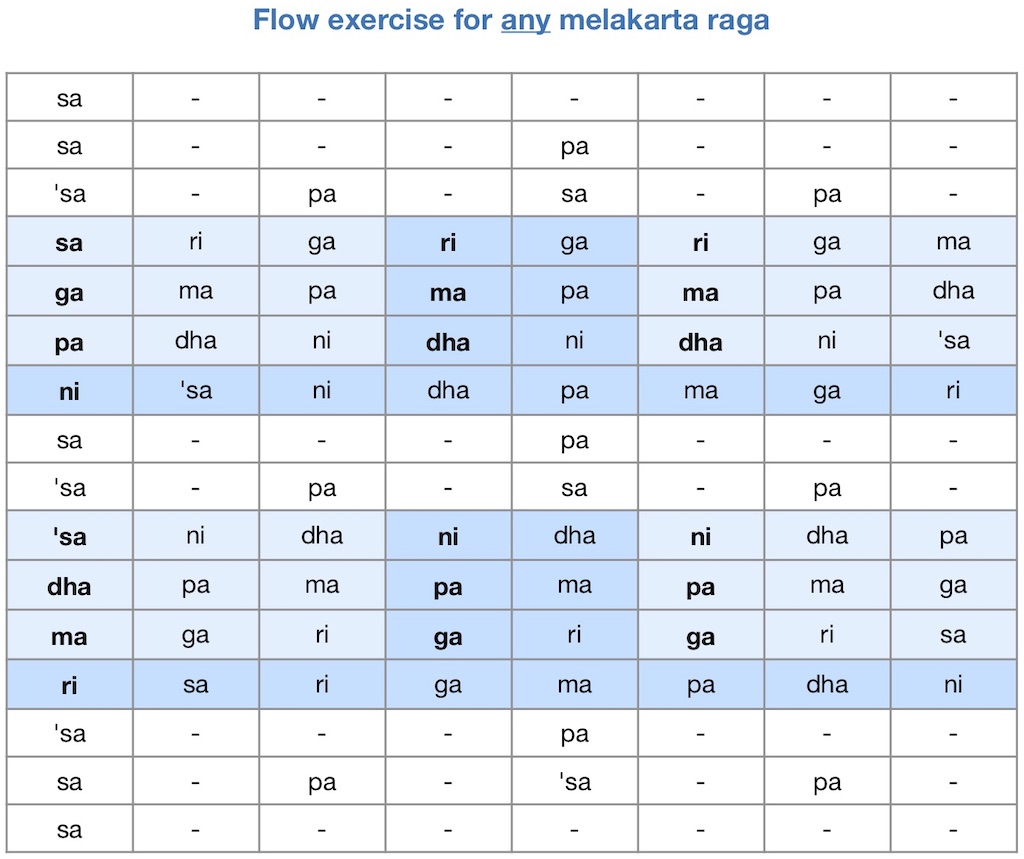Colours, moods and feelings have been favourite subjects in the context of raga, literally “colour, beauty, pleasure, passion and compassion”.1
We are aware that the ultimate aim of every composer and musician is to achieve the coalescence, the essential factors of classical music namely bhava, raga and tala. | Learn more >>
Explore this wonderful realm in imaginative ways – always in accordance with your own creativity and feelings
Suggestions for widening the scope for the “Flow”-exercises offered in this course:
- Alternate the singing of svara syllables with humming (-m):
– lines wherein 3-2-3 svaras are highlighted become “3 svaras sung + 2 svaras hummed + 3 svaras sung”
– lines wherein 8 svaras are highlighted become “4 svaras sung + 4 svaras hummed” - Instead of humming (-m), extend the vowel found in the preceding svara variant (-a, -i)
- As always, “be patient” …
To get going, click on “Details” and enjoy your practice!
Details
Select one of the exercises offered here:
Listen to Uma Ramasubramaniam demonstrating the svaras (notes) for the present raga(s) on Raga Surabhi >>
Note: this recording has no fifth note “Pa”
(as advised for those janya ragas wherein “Pa” will not be sung or played)
Download this audio file (2 MB, 2 min. mono)
Credit: eSWAR / FS-3C Sruthi petti + Tanjore Tambura
Here comes another challenge
Details
Designed for anyone in search of new “Flow-” horizons through music:
- Vary the vowels of svara syllables: –a, -i and -u yield ra-ri-ru, ga-gi-gu, ma-mi, dha-dhi-dhu, na-ni-nu.2
- Examples
– in raga Sankarabharanam (seven notes, mela 29), the variants sung are: “sa ri gu ma pa dhi nu”3
– these variants also apply to many janya ragas like Hamsadhvani: “sa ri gu pa nu” (five notes)
– in melakarta raga Gamanasrama (seven notes, mela 53), the corresponding variants are: “sa ra gu mi pa dhi nu“
– its janya raga Hamsanandi (six notes) lacks pa: “sa ra gu mi dhi nu“
– other variants apply to janya raga Sriranjani: “sa ri gi ma dhi ni“
– the “parent raga” for Sriranjani (six notes) is Kharaharapriya (seven notes, mela 22) to which the following variants apply: “sa ri gi ma pa dhi ni”
- To learn more about the association of sound with colour, search the internet using the term “synesthesia”; according to a source cited on Wikipedia “individuals rarely agree on what color a given sound is”. [↩]
- These variations traditionally serve as memory aids (mnemonics) even if hardly used today:
“a” for the lowest variant, “i” for the middle one, and “u” for the highest one, always depending on the melakarta raga a given janya raga is associated with. [↩] - Please remember: sa and pa never vary (though pa is sometimes omitted altogether); ri, ga, dha and ni have three variants each (-a, -i and -u); and ma has two variants (-a and -i). [↩]



